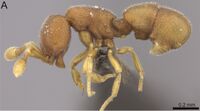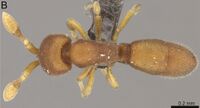Discothyrea michelae
| Discothyrea michelae | |
|---|---|

| |
| Scientific classification | |
| Kingdom: | Animalia |
| Phylum: | Arthropoda |
| Class: | Insecta |
| Order: | Hymenoptera |
| Family: | Formicidae |
| Subfamily: | Proceratiinae |
| Tribe: | Proceratiini |
| Genus: | Discothyrea |
| Species group: | traegaordhi |
| Species: | D. michelae |
| Binomial name | |
| Discothyrea michelae Hita-Garcia & Lieberman, 2019 | |
The species is known only from the type locality in the Kindoroko Forest, Tanzania, where it was collected from leaf litter in a primary montane forest at an elevation of 1739 m.
Identification
Hita-Garcia and Lieberman (2019) - The structure of the petiole is unique among the Afrotropical fauna: no other species approximates the rectangular outline of the petiolar node, with sharp dorsolateral peaks and a deeply impressed anterior face, the node therefore appearing bilobed. The following character combination further distinguishes D. michelae from the remainder of the complex:
- abdominal sternite 3 with strongly developed median ridge anteriorly surpassing prora, appearing rectangular in profile
- standing pilosity present on mesosoma and abdominal terga
- propodeum denticulate, declivity deeply concave
The shape of the petiolar node is unique among the Afrotropical fauna and is unusual for Discothyrea in general. This species is otherwise quite similar in general habitus to Discothyrea kalypso, and is allied with Discothyrea hawkesi, Discothyrea maia, and Discothyrea penthos by the denticulate propodeum and a modified abdominal sternite 3.
Based on the small type series, D. michelae varies somewhat in the structure of the subpetiolar process, which may be more slightly more lobate or more rectangular.
Keys including this Species
Distribution
Latitudinal Distribution Pattern
Latitudinal Range: -3.7452° to -3.7452°.
| North Temperate |
North Subtropical |
Tropical | South Subtropical |
South Temperate |
- Source: AntMaps
Distribution based on Regional Taxon Lists
Afrotropical Region: United Republic of Tanzania.
Distribution based on AntMaps
Distribution based on AntWeb specimens
Check data from AntWeb
Countries Occupied
| Number of countries occupied by this species based on AntWiki Regional Taxon Lists. In general, fewer countries occupied indicates a narrower range, while more countries indicates a more widespread species. |

|
Estimated Abundance
| Relative abundance based on number of AntMaps records per species (this species within the purple bar). Fewer records (to the left) indicates a less abundant/encountered species while more records (to the right) indicates more abundant/encountered species. |

|
Biology
Castes
 X-ray micro-CT scan 3D model of Discothyrea michelae (worker) prepared by the Economo lab at OIST.
X-ray micro-CT scan 3D model of Discothyrea michelae (worker) prepared by the Economo lab at OIST.
See on Sketchfab. See list of 3D images.
Nomenclature
The following information is derived from Barry Bolton's Online Catalogue of the Ants of the World.
- michelae. Discothyrea michelae Hita Garcia & Lieberman, in Hita Garcia, Lieberman, et al. 2019: 56, figs. 4M, 6M-12M, 14M, 43, 44 (w.) TANZANIA.
- Type-material: holotype worker, 1 paratype worker.
- Type-locality: holotype Tanzania: Kilimanjaro, Mwanga, Kindoroko Forest Reserve, -3.7452, 37.64267, 1739 m., CEPF-TZ-5.2, 5-8.ix.2005, primary forest, leaf litter (P. Hawkes, J. Makwati & R. Mtana); paratype with same data.
- Type-depositories: SAMC (holotype); BMNH (paratype).
- Distribution: Tanzania.
Description
Worker
(n = 2) EL 0.01–0.02; HL 0.50–0.52; HW 0.41–0.43; SL 0.26; PH 0.26– 0.28; PW 0.28–0.30; DML 0.38; PrH 0.28–0.33; WL 0.55–0.58; HFL 0.30; PeL 0.05–0.06; PeW 0.19–0.20; PeH 0.20–0.21; LT3 0.35–0.38; LT4 0.38–0.40; OI 2–4; CI 82–83; SI 50–52; LMI 47–48; DMI 51–52; DMI2 73–78; ASI 107; HFI 52–55; DPeI 333–380; LPeI 333–420.
Head longer than broad (CI 82–83), posterior head margin straight, posterodorsal corners of head rounded; sides of head in frontal view slightly convex; eyes minute, a simple pigmented spot, situated slightly less than one-third of the way between anterolateral corner of gena and posterior head margin, not visible in frontal view; frontal lamella broadly rounded-triangular in profile, apex rounded; lamella more translucent basally, but without clearly defined fenestra; medial clypeus transverse to weakly convex, lateral clypeus curving gently between antennal sockets and anterolateral corners of head, bearing numerous short, curved setae, densest medially. Antenna with fairly short scape (SI 50–52), scape strongly incrassate, gently bent; pedicel campaniform, longer than broad; true antennomere count ten; apparent antennomere count ten; flagellomeres basad apical club highly compressed, taken together only about as long as apical club. Ventral head with moderately well-developed, weakly sinuate preoccipital ridge, with short, triangular anteromedial carina; medial region of hypostoma broadly triangular, arms somewhat narrowed and spatulate apicolaterally; palpal formula not examined. Mandible with slight subapical angle; subbasal angle and basal angle squared; ectal face with bracket-shaped carina running from just distad basal angle to subapical angle, leaving long, narrow depressed region.
Mesosoma gracile, sloping posteroventrally, pronotum slightly higher than propodeum; in dorsal view mesosoma conspicuously slender and elongate (DMI 51–52; DMI2 73–78), slightly narrowed posteriorly, pronotum much wider than propodeum; pronotal humeri rounded to almost angulate; posterior propodeal margin strongly convex between denticles; posterodorsal corners of propodeum dentate, teeth acutely triangular, laterally flattened, diverging posterolaterally; declivitous face of propodeum strongly concave in profile and oblique posterior view; propodeal spiracle inconspicuous, directed posteroventrally; propodeal lobes well-developed, rounded-flangelike.
Legs short (HFI 52–55); mesotibia without apicoventral spur, with small but distinct apicoventral seta inserted in pit; mesobasitarsus short, shorter than tarsomeres II–IV taken together.
Petiolar node strongly attenuated dorsomedially, about 3.3 to 4.2 times higher than long (LPeI 333–420); in profile attenuation not as apparent (since node shortest medially); anterior face of node subvertical to anteriorly sloping, apex truncate to peaked, posterior face sloping posteroventrally; in dorsal view, petiole about 3.3 to 3.8 times wider than long (DPeI 333–380); sides divergent posteriorly, posterior margin slightly concave, anterior margin strongly concave; in anterior view, petiolar outline basically rectangular, dorsolateral corners sharply peaked, dorsal maring therefore concave; in oblique anterodorsal view, anterior face strongly impressed medially, node appearing bilobed; subpetiolar process short, lobate to rectangular, apex flat to truncate.
Abdominal segment 3 with tergite elongate-campaniform, anteriorly prolonged slightly over helcium, widest posteriorly; sternite distinctly squared in profile; AS3 with very strongly developed median ridge with defined anteroventral and posterior faces, ridge broadening to a lobe posteriorly, anteriorly surpassing prora; prora well-defined, concave in ventral view; AT4 weakly longer than AT3 (ASI 107); AT4 shaped as quarter-section of prolate ellipsoid; AS4 with well-developed, fairly broad anterior lip, overlapping about two-third the width of AS3, anterior margin concave with rounded anterolateral edges in ventral view; successive abdominal segments short, telescopic, often concealed.
Sculpture on head foveolate laterally, foveolae becoming denser and smaller on front of head; ventral surface of head foveolate to punctulate, smoothest medially; small foveolae extending to frontal lamella and clypeus; mandible with numerous, fine piligerous punctulae; mesosoma and petiole more or less regularly, shallowly punctate-reticulate, some foveolae coarser on lateral pronotum; declivitous face of propodeum foveolate-reticulate; abdominal segment 3 and AT4 similarly sculptured, foveolae slightly smaller than those on mesosoma, shallower on AT4; AT4 slightly shinier than AT3.
Setation on head mostly appressed fine pubescence, some suberect hairs present particularly on front of head and posterior head margin; scape with long pubescence, a few decumbent hairs present apically; ectal face of mandible with moderately long, fine, appressed to decumbent setae; masticatory margin with row of straight, stout setae; lateral mesosoma and abdominal terga with very dilute pubescence; numerous short decumbent to erect setae present on mesosomal and abdominal dorsa; petiolar sternite and abdominal sternite 3 without standing hairs; abdominal segments 5 to 7 with relatively short, abundant standing hairs, not much longer than those on AT4; legs with appressed pubescence and a few scattered decumbent to erect setae.
Type Material
See the beginning of this ("Nomenclature") section for detailed information about the specimen types. A cyber-type of the holotype is also available. This includes: Volumetric raw data (in DICOM format), 3D rotation video, still images of surface volume rendering, and 3D surface (in PLY format) of the physical holotype (South African Museum: CASENT0235469) in addition to stacked digital color images illustrating the head in full-face view, plus profile and dorsal views of the body. The data are deposited at Dryad and can be freely accessed as virtual representations of the type. There is also a Sketchfab 3D surface model of the holotype. It is shown above, in the Caste section, and at Sketchfab (see the link in the Caste Section).
Etymology
Discothyrea michelae is named in appreciation of Michele Esposito from San Francisco, USA, the incomparable data manager for AntWeb. For years, she has worked tirelessly as part of the AntWeb team to organize and make available huge quantities of data used by countless myrmecologists. Like the new species, Michele is unique among her peers. The specific epithet is given as a genitive noun.
References
- Hita-Garcia, F., Lieberman, Z., Audisio, T.L., Liu, C., Economo, E.P. 2019. Revision of the highly specialized ant genus Discothyrea (Hymenoptera: Formicidae) in the Afrotropics with x-ray microtomography and 3D cybertaxonomy. Insect Systematics and Diversity 3(6): 5; 1–84 (doi:10.1093/isd/ixz015).
References based on Global Ant Biodiversity Informatics
- Hita-Garcia F., Z. Lieberman, T. L. Audisio, C. Liu, and E. P. Economo. 2019. Revision of the highly specialized ant genus Discothyrea (Hymenoptera: Formicidae) in the Afrotropics with X-ray microtomography and 3D cybertaxonomy. Insect Systematics and Diversity 3(6): 5:1-84.

